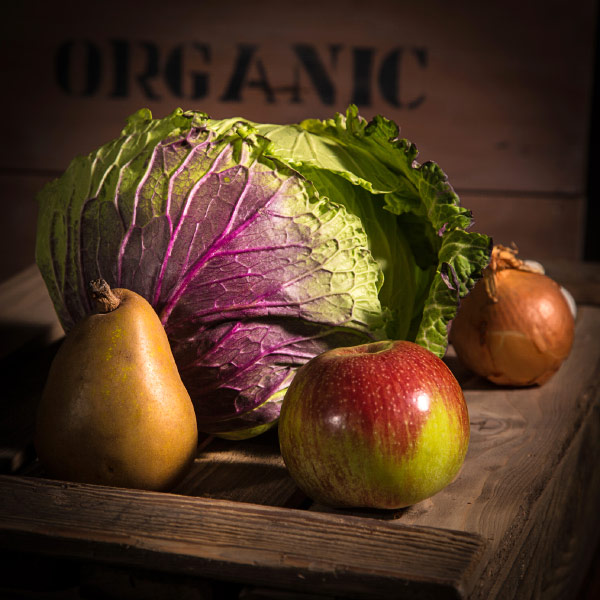Challenges and Opportunities for Ecologically-Based Growers
 |
|
Still life with organic fruit and vegetables |
Aldo Leopold, who in 1949 published The Land Ethic, a founding text of the conservation movement, knew the challenges for the farmer: Feed a growing population, improve the productivity of agricultural land, and protect the integrity of the environment for future generations. Today, an increasing number of people have expectations for higher quality food—for example, organic, unprocessed, unpackaged, and healthy products. Even as expectations rise, we face water and air pollution, loss of beneficial organisms, and increasing persistence of pests. Yet these challenges are being met by the organic movement and the IPM tradition, whose adherents see a need for greater adoption of IPM and organic farming among growers and the general public.
The benefits of organic growing are many: fewer adverse environmental impacts, no synthetic pesticide residues, and documented improvements in nutritional quality in dairy and in some fruits and vegetables. The benefits of IPM: reduced reliance on single tactics, as well as reduced pesticide residues, production costs, risks, and health and environmental impacts. Fundamental principles of IPM can be applied to any pest problem.
One of the limitations of organic growing is the rigorous restriction of pesticide and fertilizer inputs, all of which must be derived from natural products. Meanwhile, a limitation of IPM is that, on a continuum, the benefits are dependent on the extent to which tactics are adopted. Also there is lack of consumer understanding of IPM.
There are commonalities to organic, IPM, and even conventional farming. Organic producers practice IPM, for example, by using cultural, biological, and in some cases chemical controls. Some ecologically-based growing practices are becoming more common in conventional farming, including cover crops and reduced tillage systems. Organic food has broad consumer awareness and support, price premiums, and a clear set of standards through the National Organic Program (NOP).
Both types of ecologically-based growing, organic and IPM, are knowledge-intensive and require a systems approach that focuses on understanding a problem, rather than simply applying patent- and revenue-driven products in the field. This is a major constraint to greater adoption of organic and IPM. Ecologically-based growing may cost more in the short term, yet it pays off in the long term. Ecologically-based growing delivers ecosystem services, such as clean water, soil health, and environmental biodiversity, not to mention a sustainably-grown crop. Despite these benefits, market premiums are necessary to provide incentives for growing organic food, while demand outstrips supply. Meanwhile, IPM is not recognized by retail consumers. In this context, one could argue that IPM and organic would be best served by positioning themselves together under a single “ecologically-based growing” umbrella.
Adherents of IPM and organic growing share common priorities. Ecologically-based growers need increased resources for research, technology transfer, education, and outreach. In addition, public policy and private-sector incentives could be added to level the playing field. There are answers for growers battling long-fought pests like fire blight in apples and pears, late blight in tomatoes and potatoes, and agriculture weeds that thrive in reduced-tillage systems. Ecologically-based approaches could tackle newly introduced pests that loom large, such as spotted wing drosophila, brown marmorated stink bug, and Asian citrus psyllid. However, the political and social interest in learning them is often lacking. Ecologically-based solutions, which are rarely discovered overnight nor through a single company or individual, take consistent, sustained efforts by the widest group who is willing to share in both the challenges and the successes.
Organic and IPM groups are finally working together. But this shouldn’t be such a revelation. Individuals using ecologically-based methods have been working together for centuries prior to the chemical revolution and Rachel Carson’s book Silent Spring. The critical issues of today, such as climate change, pesticide resistance, and off-target chemical movement, are driving us back to the basics upon which organic and IPM were founded. We need resilient farming systems that can endure environmental problems that are occurring naturally and due to our own mistakes. We need to look in the mirror and ask ourselves the question, “Is this the best we can do?” If Aldo Leopold was looking to a sustainable future, so should we.
This article is based on work of the North Central IPM Center’s Organic and IPM Working Group.
— by CHRIS GONZALES and STEVE YOUNG
The Northeastern IPM Center promotes integrated pest management for reducing risks to human health and the environment. If republishing our news, please acknowledge the source (“From Northeast IPM Insights”) along with a link to our website.
